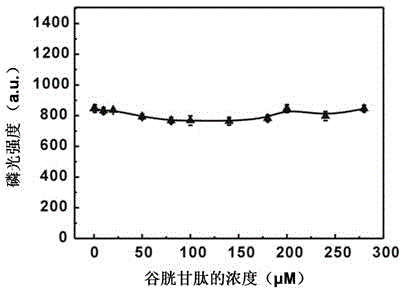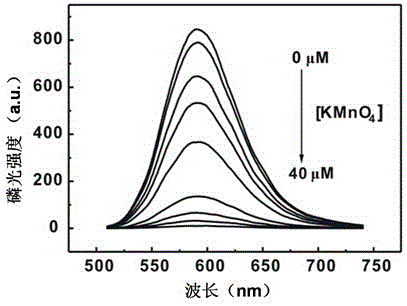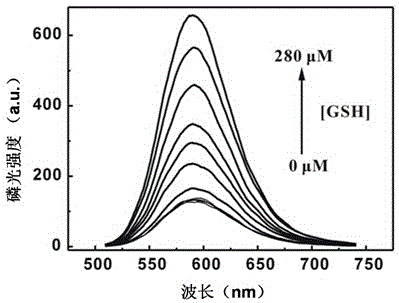Application of phosphorescent quantum dot in selective detection of glutathione in biological fluid and wine
A technology of glutathione and quantum dots, which is applied in the direction of fluorescence/phosphorescence, material excitation analysis, etc., can solve the problems of lack of selectivity and achieve the effect of enhancing selectivity, avoiding sample pretreatment process, and exempting sample pretreatment process
- Summary
- Abstract
- Description
- Claims
- Application Information
AI Technical Summary
Problems solved by technology
Method used
Image
Examples
Embodiment 1
[0038] 1、 Synthesis of Mn:ZnS Phosphorescent Quantum Dots
[0039] MPA, Zn(CH 3 COOH) 2 and Mn (CH 3 COOH) 2 , where MPA:Zn (CH 3 COOH) 2 : Mn (CH 3 COOH) at a molar ratio of 4:1:0.1. The pH value of the solution was adjusted to 11 with NaOH, the above mixed solution was protected by nitrogen, stirred at room temperature for 30 min, and Na 2 S and Zn (CH 3 COOH) 2 The molar ratio is 1:1 to Na 2 The S solution was quickly injected into the solution, continued to stir at room temperature for 20 min, then heated to 50 °C for 2 hours in the air with a constant temperature stirrer, added absolute ethanol, centrifuged, and vacuum-dried to obtain the Mn-doped ZnS quantum dot product.
Embodiment 2
[0041] 1、 Synthetic method with reference to embodiment 1
[0042] 2、 Phosphorescent quantum dots Mn:ZnS for the detection of glutathione in solution
[0043] (1) Add 0.01mL phosphorescent quantum dot mother solution and 1 mL Tris-HCl buffer solution to the centrifuge tube in proportion, add 0.3 μM glutathione (GSH) solution to the mixed solution, add water to make up to 10 mL, After standing for 10 minutes, phosphorescence detection was performed with a fluorescence spectrophotometer.
[0044] (2) Add 0.05 mL of phosphorescent quantum dot mother solution and 1 mL of Tris-HCl buffer solution to the centrifuge tube in proportion, add potassium permanganate solutions of different concentrations of 1 μM to the mixed solution, add water to make up to 10 mL, and statically After standing for 10 minutes, phosphorescence detection was performed with a fluorescence spectrophotometer.
[0045] (3) Add 0.01 mL phosphorescent quantum dot mother solution and 1 mL Tris-HCl buffer solut...
Embodiment 3
[0047] 1, synthetic method with reference to embodiment 1
[0048] 2. Phosphorescent quantum dot Mn:ZnS for the detection of glutathione in solution
[0049] (1) Add 0.05mL phosphorescent quantum dot mother solution and 1 mL Tris-HCl buffer solution to the centrifuge tube in proportion, add 10 μM glutathione (GSH) solution to the mixed solution, add water to make up to 10 mL, After standing for 10 minutes, phosphorescence detection was performed with a fluorescence spectrophotometer.
[0050] (2) Add 0.1 mL phosphorescent quantum dot mother solution and 1 mL Tris-HCl buffer solution in proportion to the centrifuge tube, add potassium permanganate solutions with different concentrations of 5 μM to the mixed solution, add water to make up to 10 mL, and statically After standing for 10 minutes, phosphorescence detection was performed with a fluorescence spectrophotometer.
[0051] (3) Add 0.05 mL phosphorescent quantum dot mother solution and 1 mL Tris-HCl buffer solution to th...
PUM
 Login to View More
Login to View More Abstract
Description
Claims
Application Information
 Login to View More
Login to View More - R&D
- Intellectual Property
- Life Sciences
- Materials
- Tech Scout
- Unparalleled Data Quality
- Higher Quality Content
- 60% Fewer Hallucinations
Browse by: Latest US Patents, China's latest patents, Technical Efficacy Thesaurus, Application Domain, Technology Topic, Popular Technical Reports.
© 2025 PatSnap. All rights reserved.Legal|Privacy policy|Modern Slavery Act Transparency Statement|Sitemap|About US| Contact US: help@patsnap.com



